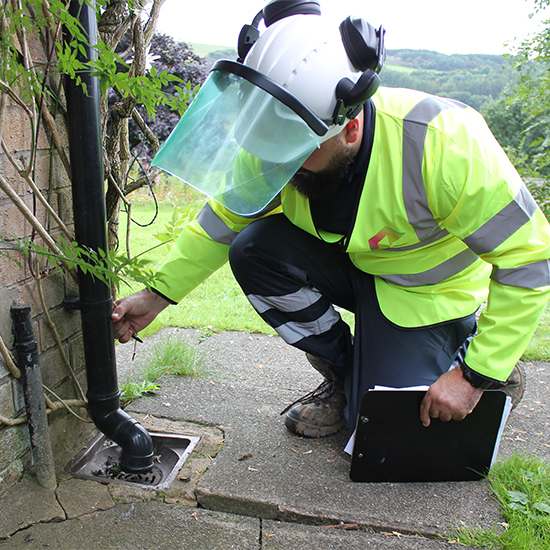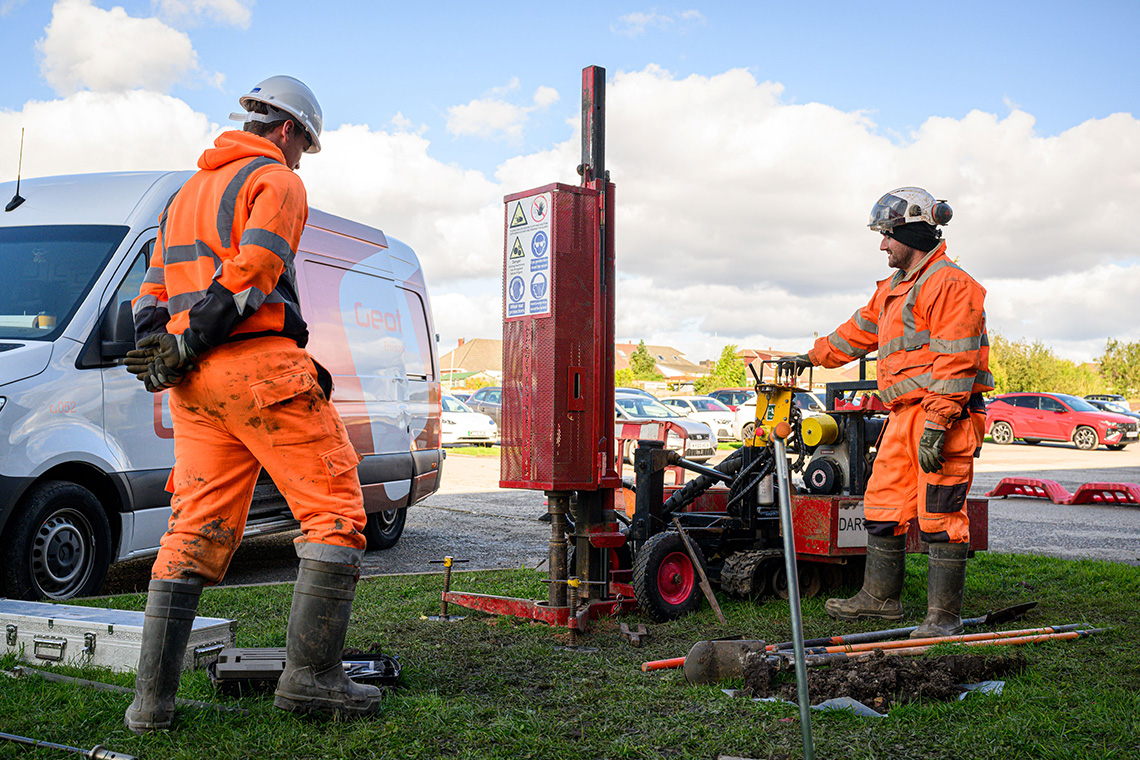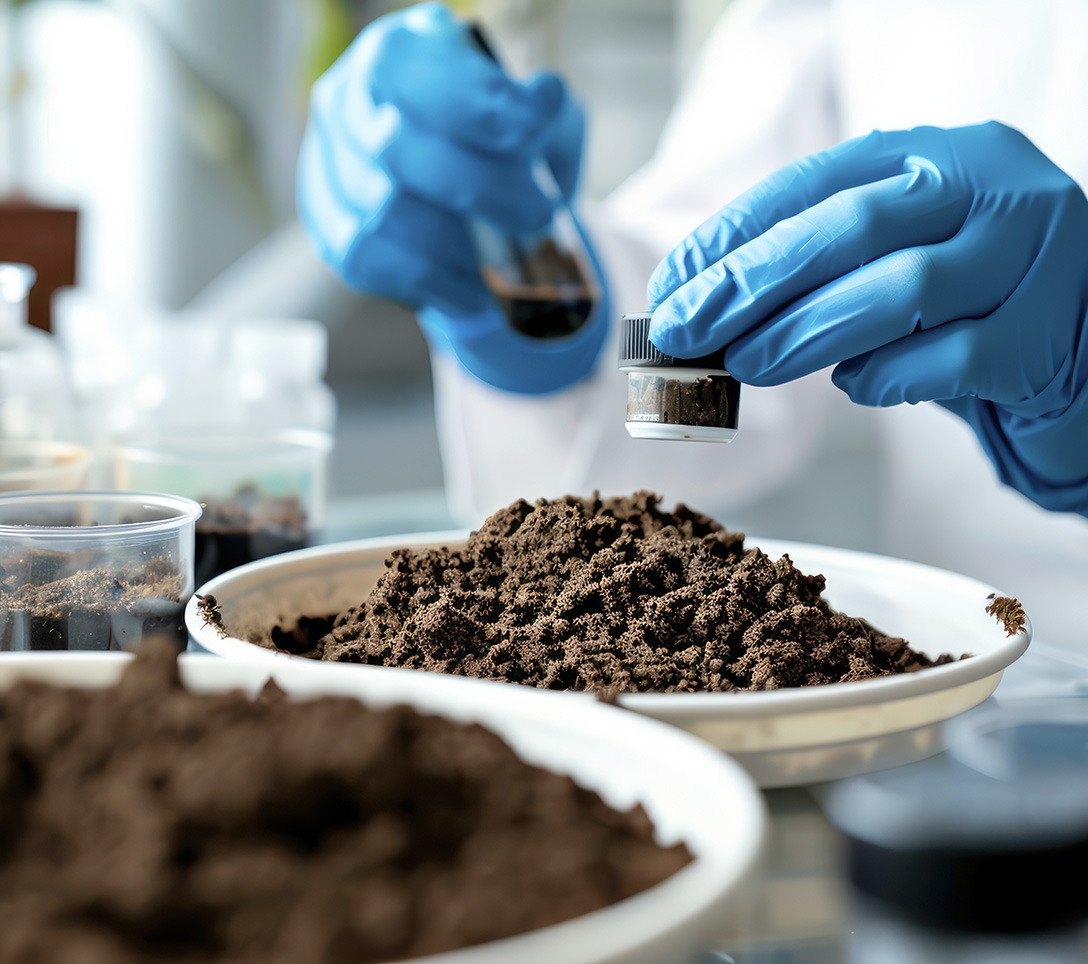December 15, 2025
Catalyst colleagues share Christmas cheer with local families
Colleagues at Catalyst Services UK have helped the company provide Christmas gifts for families,...

This is Part 2 of a three part guide to subsidence, drawing on the expertise of Catalyst teams in undertaking subsidence site investigations, drainage investigations, and subsidence monitoring – especially for insurance claims clients and their customers.
Here, we explain how subsidence investigations are carried out, and the range of techniques used to establish if subsidence is occurring and what is causing it. The guide also details the importance of subsidence monitoring and the methods for doing this.
Our Subsidence Service Guide Part 1 provides an overview of what subsidence is (and what it is not), the general terms that define it, its causes and how it can be detected. In Part 3, we look at subsidence repair, prevention and insurance.
The first response if you think your property is at risk from subsidence or has been affected by it, is to carry out an appropriate subsidence investigation.
The nature of the investigation will depend on the particular signs of possible subsidence present. Different elements of the investigation may be carried out by different technical specialists.
For example, an investigation of ground conditions will be conducted by a civil engineer or geologist. The impact of suspected subsidence on a building may need to be examined by a structural engineer.
Meanwhile, the possible contribution to a suspected subsidence issue is likely to be investigated by an arboriculturist.
In each case, a range of subsidence investigation techniques will be considered. One of the most common is the collection of soil samples through borehole drilling. Another is to dig as trial pit to examine foundations and the ground around them.

The subsidence investigation may establish if subsidence has taken place. If it does not provide conclusive evidence of subsidence, it may be decided that the best course of action is to carry out crack and level monitoring (see below).
If subsidence is identified, along with its causes, remedial action may be taken. For example, if it is shown that a faulty drainage or water supply system has caused the subsidence, the faults can be repaired.
Or, if it is found that trees are a primary cause of the subsidence, action can be taken to prevent further damage. In both cases, a period of further monitoring is likely to be recommended to ensure the action taken has resolved the subsidence problem and the property is no longer at risk.
This monitoring period is likely to last 6 months to a year due to the long periods of time over which subsidence can take effect, and to take account of seasonal changes in soil conditions and other risks, including vegetation growth.
A subsidence survey, or subsidence investigation, is a procedure carried out to establish if subsidence has occurred. Another objective is to establish what is its cause. A range of techniques is used, including visual inspection and other, more sophisticated tests and monitoring techniques. A subsidence survey is the first step towards establishing what remedial measures can be taken.
A trial pit investigation, also known as a trial hole investigation, involves the digging of a hole to assess the condition of building foundations and the ground substrates associated with them.
It also allows the materials used to build a foundation and its proportions, including its depth, to be accurately measured. This is called a foundation drawing, or log.

A bore hole investigation involves a hole being drilled by a hand auger or a machine to gather soil samples around a building foundation. This could be in the bed of the trial pit or at other places around a structure.
Bore hole investigations allow the condition of substrates at different depths beneath foundations to be assessed. They can reveal moisture levels and movement within substrates that could indicate the presence, specific locations, and extent of subsidence.

A shear vane test is an in situ geotechnical test that measures the undrained shear strength of undrained clay (cohesive) soils. It is a relatively quick and cost-effective way to assess the likelihood of a soil breaking down, resulting in increased subsidence risks.
A shear vane test is carried out by driving a rod with vanes mounted on the end if it into the ground. The rod is then rotated. A gauge on the rod measures the effort needed for the vanes to break through the soil. This allows a calculation to me made of the soil’s shear strength.

Mackintosh probe in-situ testing is used to identify the bearing strength of soils at different depths. It consists of a rod that is driven into the ground.
The amount of force needed for the rod to move through the soil is an indication of the condition and resistance to downward pressure of different layers of soil. This provides useful information about soil conditions that might cause subsidence or increase the risk of it occurring.
A tree subsidence report is the document created to present the findings of technical investigation carried out to assess the potential contribution of trees to an incidence of subsidence.
A tree subsidence report can also be commissioned to assess the risk of trees contributing to the subsidence of a property or properties at some time in the future.
Other names for such documents are arboricultural report, subsidence tree survey report, and tree impact assessment report, and arboricultural appraisal report.
Laboratory soil testing involves the analytical testing of soil and other material samples in controlled laboratory conditions. This allows the physical and chemical characteristics of the soils to be identified, in case they are associated with the cause of subsidence or increasing the risk of it happening.
Laboratory root testing, including tree root DNA testing, is the testing of root samples taken from trial holes and bore holes to assess the tree species.
The presence, location and interaction of the root from which the sample was taken can then be matched with nearby trees to assess which ones may be associated with subsidence or with increasing the risk of it happening.

Crack monitoring is the systematic observation and measurement of cracks in a building’s structure to assess whether they are caused by subsidence.
The technique is used to evaluate the progression or stabilisation of ground movement over time. It also provides essential data to diagnose the cause of cracks and determine appropriate remediation.

Diagnosing subsidence: The presence and development of cracks indicate where and how subsidence is progressing, so monitoring them helps identify the primary cause of the ground movement.
Assessing severity: The presence of cracks does not always mean subsidence has occurred. Some cracks are superficial or have other causes, for example thermal expansion. Crack monitoring helps identify the level of risk to the structure.
Tracking movement: Subsidence-related cracks may widen (or even close), lengthen, or move over time. Monitoring them helps predict how ground conditions will change over time.
Guiding repairs: Crack monitoring provides accurate data needed to plan effective remedial measures, such as underpinning or soil stabilisation, and to then monitor their effectiveness.
Insurance claims and legal evidence: The process creates a record of structural changes for insurance claims or legal disputes.
Crack monitoring involves a combination of visual inspections and the use of different instrumentation:
Tell-tale gauges: These are transparent plastic gauges with overlapping scales that are installed across the crack. They are used to measure horizontal and vertical movement by tracking changes in alignment.
Digital and laser crack monitors: To measure displacement more accurately, technicians can install electronic sensors or laser systems.
Displacement transducers: These measure fine movements of the crack in three dimensions.
Strain gauges: Strain gauges are used to monitor stress in materials near the crack. The technique helps identify the risk of further damage before it occurs.
Smart monitoring systems: Many of these devices can be connected to the internet via cloud-based systems to allow remote collection and real-time analysis of crack monitoring data.
Cracks are typically monitored over several months, and sometimes years, to take account of seasonal changes in soil moisture and vegetation activity, which can influence subsidence.
If the cracks are not being monitored remotely using digital systems, technicians will attend sites at intervals based on the severity of the crack or cracks and local environmental factors.
Building level monitoring involves observing, measuring, and assessing the movement or settlement of a structure over time to identify signs of subsidence or other structural issues.
It is an essential process to detect if subsidence is happening, its extent, and the most appropriate action to take to stop it, repair the structure and prevent subsidence happening in the future.
Building level monitoring is an essential part of managing subsidence risks and maintaining property values. It is often carried out in collaboration between structural engineers, geotechnical specialists, and insurers.
Detect subsidence: Identify and quantify ground movement that may indicate subsidence.
Assess risk: Determine the impact of soil movement on the stability and safety of the building.
Guide repairs: Provide data to plan and execute effective remedial actions.
Monitor effectiveness: Evaluate the success of implemented solutions over time.

Building level monitoring involves the use of various techniques and tools to measure movement. These can include:
Manual surveying: Regularly measuring and recording levels at key points on the building using tools like spirit levels or dumpy levels.
Automated monitoring: Using instruments like tilt sensors, inclinometers, or laser levels for continuous or periodic data collection.
Fixed reference points: Installing datum points or markers on the building to track displacement over time.
Data logging and analysis: Capturing and analysing data to identify trends, such as the speed and of settlement (over time or at different points across the building footprint) or sudden shifts.
Vertical displacement: Changes in the building’s level relative to a stable reference point.
Horizontal movement: Shifts in walls, foundations, or other structural elements.
Subsidence diagnosis: To confirm whether ground movement is affecting a structure.
Foundation monitoring: To assess how foundations respond to changes in soil condition and remediation measures, such as underpinning.
Infrastructure safety: To make sure critical and valuable structures remain stable and safe, for example, retaining walls or historical buildings.
Early detection: It is an essential component of timely intervention before significant and costly damage occurs.
Informed decision-making: Building level monitoring provides reliable data needed to identify the best solutions to a multi-faceted, complex issue.
Cost-effectiveness: It avoids unnecessary repairs by pinpointing the exact areas of concern.
Insurance claims compliance: Building level monitoring is often required by insurers and loss adjustors to precisely identify the scope and cost of a claim.
If you need advice about the causes of subsidence and what to do about it, talk to the experts at Catalyst Services UK today.
Helping business and domestic customers every day of the year
December 15, 2025
Catalyst colleagues share Christmas cheer with local families
Colleagues at Catalyst Services UK have helped the company provide Christmas gifts for families,...
December 12, 2025
Gemma makes it a double with second Kudos of Year Award
Property claims handler Gemma has completed an amazing double by winning the Catalyst Services...
December 11, 2025
Insurance providers urged to join national body to meet the subsidence challenge
Effective communication will be vital if the insurance claims industry is to respond decisively...